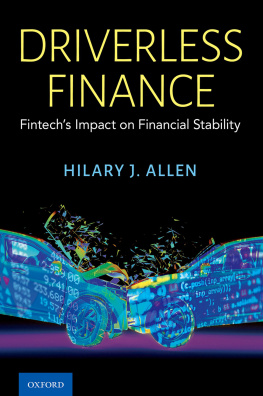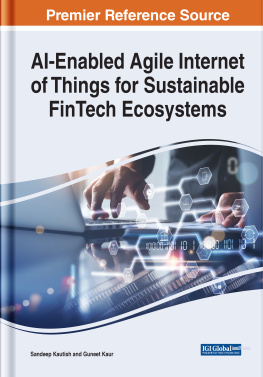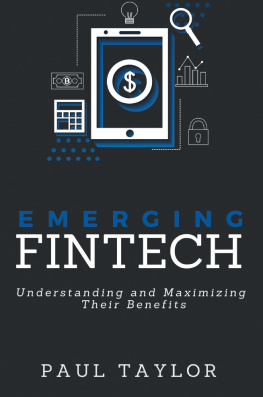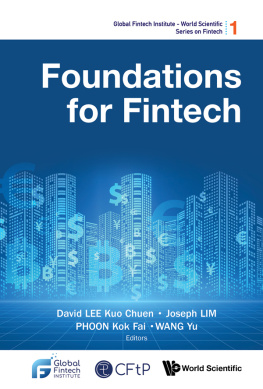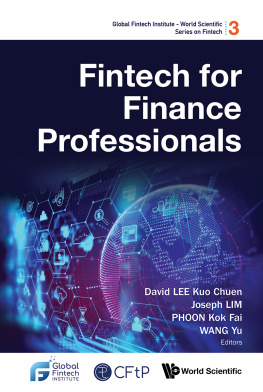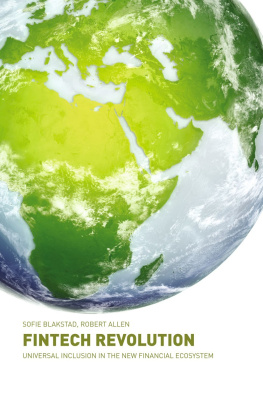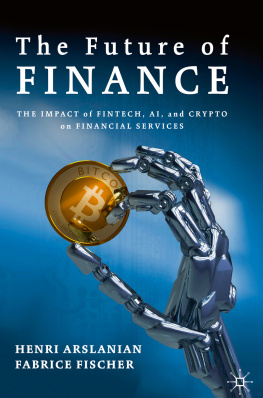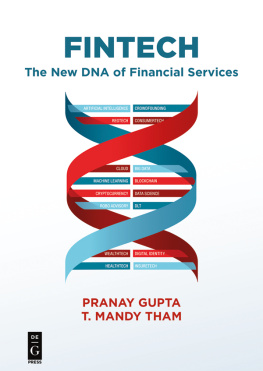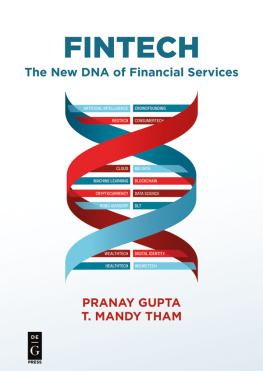Driverless Finance

Oxford University Press is a department of the University of Oxford. It furthers the Universitys objective of excellence in research, scholarship, and education by publishing worldwide. Oxford is a registered trade mark of Oxford University Press in the UK and certain other countries.
Published in the United States of America by Oxford University Press
198 Madison Avenue, New York, NY 10016, United States of America.
Hilary J. Allen 2022
All rights reserved. No part of this publication may be reproduced, stored in a retrieval system, or transmitted, in any form or by any means, without the prior permission in writing of Oxford University Press, or as expressly permitted by law, by license, or under terms agreed with the appropriate reproduction rights organization. Inquiries concerning reproduction outside the scope of the above should be sent to the Rights Department, Oxford University Press, at the address above.
You must not circulate this work in any other form and you must impose this same condition on any acquirer.
Library of Congress Cataloging-in-Publication Data
Names: Allen, J. Hilary, author. Title: Driverless finance : fintechs impact on financial stability / Hilary J. Allen.
Description: New York, NY : Oxford University Press, [2022] | Includes bibliographical references and index.
Identifiers: LCCN 2021045567 (print) | LCCN 2021045568 (ebook) | ISBN 9780197626801 (hardback) | ISBN 9780197626825 (epub) | ISBN 9780197626818 (updf) | ISBN 9780197626832 (digital-online)
Subjects: LCSH: Financial services industryLaw and legislationUnited States.
Classification: LCC KF974 .A75 2022 (print) | LCC KF974 (ebook) |
DDC 346.73/082dc23/eng/20211029
LC record available at https://lccn.loc.gov/2021045567
LC ebook record available at https://lccn.loc.gov/2021045568
DOI: 10.1093/oso/9780197626801.001.0001
Note to Readers
This publication is designed to provide accurate and authoritative information in regard to the subject matter covered. It is based upon sources believed to be accurate and reliable and is intended to be current as of the time it was written. It is sold with the understanding that the publisher is not engaged in rendering legal, accounting, or other professional services. If legal advice or other expert assistance is required, the services of a competent professional person should be sought. Also, to confirm that the information has not been affected or changed by recent developments, traditional legal research techniques should be used, including checking primary sources where appropriate.
(Based on the Declaration of Principles jointly adopted by a Committee of the
American Bar Association and a Committee of Publishers and Associations.)
You may order this or any other Oxford University Press publication
by visiting the Oxford University Press website at www.oup.com.
For Bob (my fin), George (my tech), and Linda (my stability)
Table of Contents
I would like to thank the village of people who read and commented on my drafts, including Will Allen (who embiggened the manuscript), Dan Awrey, Jon Baker, Andrew Beers, Dick Berner, Sarah Bloom Raskin, Raul Carillo, Shaanan Cohney, Gregg Gelzinis, Erik Gerding, Lewis Grossman, Cathy Hwang, Alex Joel, Aaron Klein, Rosa Lastra, Billy Magnusson, Milan Markovic, Saule Omarova, Frank Partnoy, Elizabeth Pollman, Paolo Saguato, Heidi Schooner, Dan Schwarcz, Art Wilmarth, David Wishnick, Rory Van Loo, Yesha Yadav, and David Zaring, This book benefited from their feedback and conversationbut all errors remain my own. I want to give particular thanks to Pat McCoy, who was not only instrumental in making this book a reality, but has also been a stalwart mentor and supporter.
I also want to thank the many students who participated in discussions about this book, both in my own classes at American University Washington College of Law, and in student seminars at Texas A&M and Boston University. More generally, I want to express my gratitude for a decades worth of wonderful students who have helped me hone my ability to explain many of the technical concepts in this book.
I also had lots of other kinds of help in writing this book. Abe Cable brilliantly suggested the term Driverless Finance. Washington College of Law librarians and research assistant William Ryan, Ripple Weistling, and Meagan McCullough lent their master Bluebooking skills. Last but not least, I had wonderful child-care providers who took care of my toddlers while I was writing this book. Without these caregivers (with a special shout out to the incomparable Miss Marie and the amazingly competent Miss Kim), this book could not exist.
Final Report on the Causes of the 2030 Financial and Economic Crisis in the United States
Majority Conclusions of The Financial Crisis Inquiry Commission
(as appointed by the 121st Congress)
Published October 2031
Pursuant to our charge from Congress, we have examined the causes of the financial crisis of 2030, the consequences of which still distress the global economy today. In this report we set forth our conclusions.
We conclude that the growth of the cryptoasset market was a key cause of the crisis.
Just over a decade ago, cryptoassets were a fringe asset class, mainly of interest to cypherpunks and kids trading on smartphone apps. Somewhere around 2020, though, the largest banks and other established financial institutions started to dip their toes into the water, cautious but intrigued by the potential of assets that could be created out of thin air by anyone who could write a computer program. Establishment players initially entered into derivative contracts that drew their value from cryptoassetsthe fact that a derivative was involved made the investment feel more familiar and seem more legitimate. Over time, though, they dispensed with the derivatives and started investing directly in cryptoassets. And then they started creating cryptoassets themselves.
Although problematic, this development was unsurprising. In the absence of any regulatory restrictions, the appetite for cryptoassets seemed limitless. Whole online communities were devoted to debating the merits of different types of tokens, new crypto-focused hedge funds popped up like mushrooms, and new brokerage apps made it easy for their customers to get loans to buy more and more cryptoassets. The cryptoassets bought using these apps served as collateral for these loans, and from there it was just a hop, skip, and a jump to people using cryptoassets as security for other types of loans as well. Eventually, the biggest banks started accepting cryptoassets as collateral for the loans they made to each other, and once that happened, cryptoassets were firmly embedded in the mainstream financial system.
Many people were thrilled with this brave new world of finance. Now that financial assets didnt have to be tethered to anything in the real economy, it seemed like finance had finally broken the back of the business cycle and made downturns a thing of the past. This time is different was a common refrain on Reddit pages, in investor updates from hedge funds, in the conversations that banks had with their regulators, and in the pitches lobbyists made to members of Congress. Only it wasnt different (it never is). The crypotasset market was experiencing a bubble, just like mortgage-backed securities in the 2000s, dot-com stocks in the 1990s, and tulip bulbs in the 1630s.

